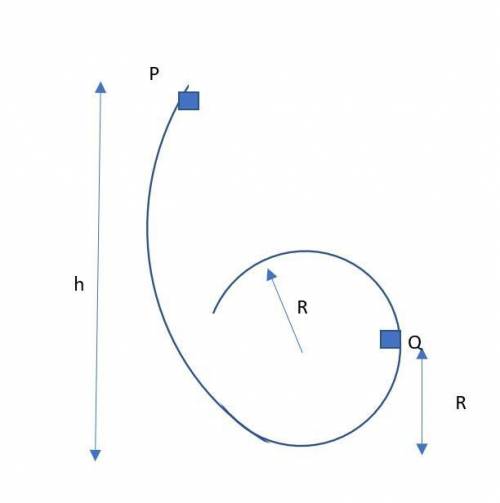
Physics, 13.11.2019 20:31 gabbylinton1113
Asmall block of mass m = 0.032 kg can slide along the frictionless loop-the-loop, with loop radius r = 12 cm. the block is released from rest at point p, at height h = 5.0r above the bottom of the loop. how much work does the gravitational force do on the block as the block travels from point p to:
a) point q? (0.15 j)
b) the top of the loop? (0.11 j) if the gravitational potential energy of the block-earth system is taken to be zero at the bottom of the loop, what is that potential energy when the block is:
c) at point p? (0.19 j) d) at point q? (0.038 j) e) at the top of the loop? (0.075 j) f) if, instead of merely being released, the block is given some initial speed downward along the track, do the answers to a) through c) increase, decrease or remain the same? (same)

Answers: 3
Another question on Physics

Physics, 21.06.2019 20:00
How much force must a locomotive exert on a 12840-kg boxcar to make it accelerate forward at 0.490 m/s2?
Answers: 1

Physics, 22.06.2019 15:00
Greg drew a diagram to compare two of the fundamental forces. which labels belong in the areas marked x, y and z? gravitational force electromagnetic force x. attractive y repulsive z: infinite range x: infinite range y attractive z. repulsive x. always attractive y: infinite range z: attractive or repulsive x. attractive or repulsive y infinite range z: always attractive
Answers: 2

Physics, 22.06.2019 15:00
Astudent throws a water balloon with speed v0 from a height h = 1.76 m at an angle θ = 21° above the horizontal toward a target on the ground. the target is located a horizontal distance d = 9.5 m from the student’s feet. assume that the balloon moves without air resistance. use a cartesian coordinate system with the origin at the balloon's initial position. (a) what is the position vector, rtarge t, that originates from the balloon's original position and terminates at the target? put this in terms of h and d, and represent it as a vector using i and j. (b) in terms of the variables in the problem, determine the time, t, after the launch it takes the balloon to reach the target. your answer should not include h. (c) create an expression for the balloon's vertical position as a function of time, y(t), in terms of t, vo, g, and θ. (d) determine the magnitude of the balloon's initial velocity, v0, in meters per second, by eliminating t from the previous two expressions.
Answers: 3

Physics, 22.06.2019 15:20
Abag of potato chips contains 2.00 l of air when it is sealed at sea level at a pressure of 1.00 atm and a temperature of 20.0 deg c. what will be the volume of the air in the bag if you take it with you, still sealed, to the mountains where the temperature is 7.00 deg c and atmospheric pressure is 70.0 kpa? assume that the bag behaves like a balloon and that the air in the bag is in thermal equilibrium with the outside air.
Answers: 3
You know the right answer?
Asmall block of mass m = 0.032 kg can slide along the frictionless loop-the-loop, with loop radius r...
Questions

Mathematics, 22.11.2021 22:00


Mathematics, 22.11.2021 22:00

Mathematics, 22.11.2021 22:00

English, 22.11.2021 22:00



Mathematics, 22.11.2021 22:00

English, 22.11.2021 22:00


Mathematics, 22.11.2021 22:00

Mathematics, 22.11.2021 22:00

Biology, 22.11.2021 22:00


Mathematics, 22.11.2021 22:00


Mathematics, 22.11.2021 22:00


Biology, 22.11.2021 22:00

Physics, 22.11.2021 22:00

















